ABOUT THE AUTHOR

IMPULSE TRAVEL TEAM
We are a team of storytellers here to bring you the best Colombia has to offer. On our blog, we answer your most frequent questions and uncover our countries mysteries, culture, and highlights for you.
In Colombia, food is deeply rooted in the culture and in sharing with the family and this is why tasting the local food is a part of experiencing the country. After all, “el amor entra por el estómago” - love goes through the stomach - trying these delicious dishes, snacks, drinks and sweets will surely spark your love for Colombia.
This blog post will give you a quick look at the stars of the Colombian cuisine that you should give a try when traveling through this fascinating country.
Table of contents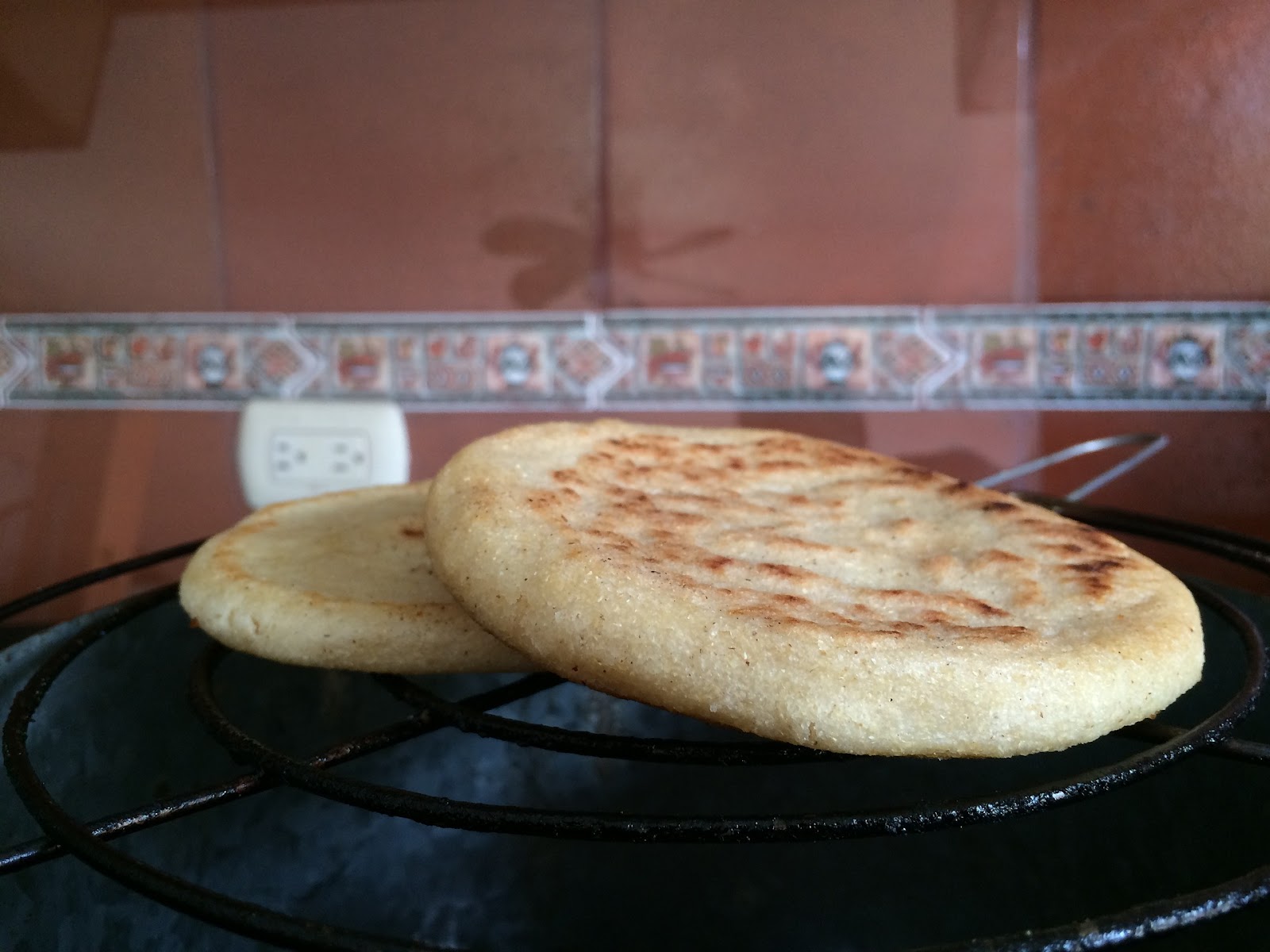
The round, flat cornbread is a staple piece for breakfast or as a snack at any time of the day. As with most local foods, there are many regional recipes for this classic snack. One of the most popular ones is the Arpea paisa from the Antioquia region. This is really the simplest version as it only contains white corn flour and water. It is baked until crispy and then enjoyed with butter and salt. You can’t get out of trying an Arepa in this country. They are such a big topic here in Colombia that we have already written an entire blog post about this topic.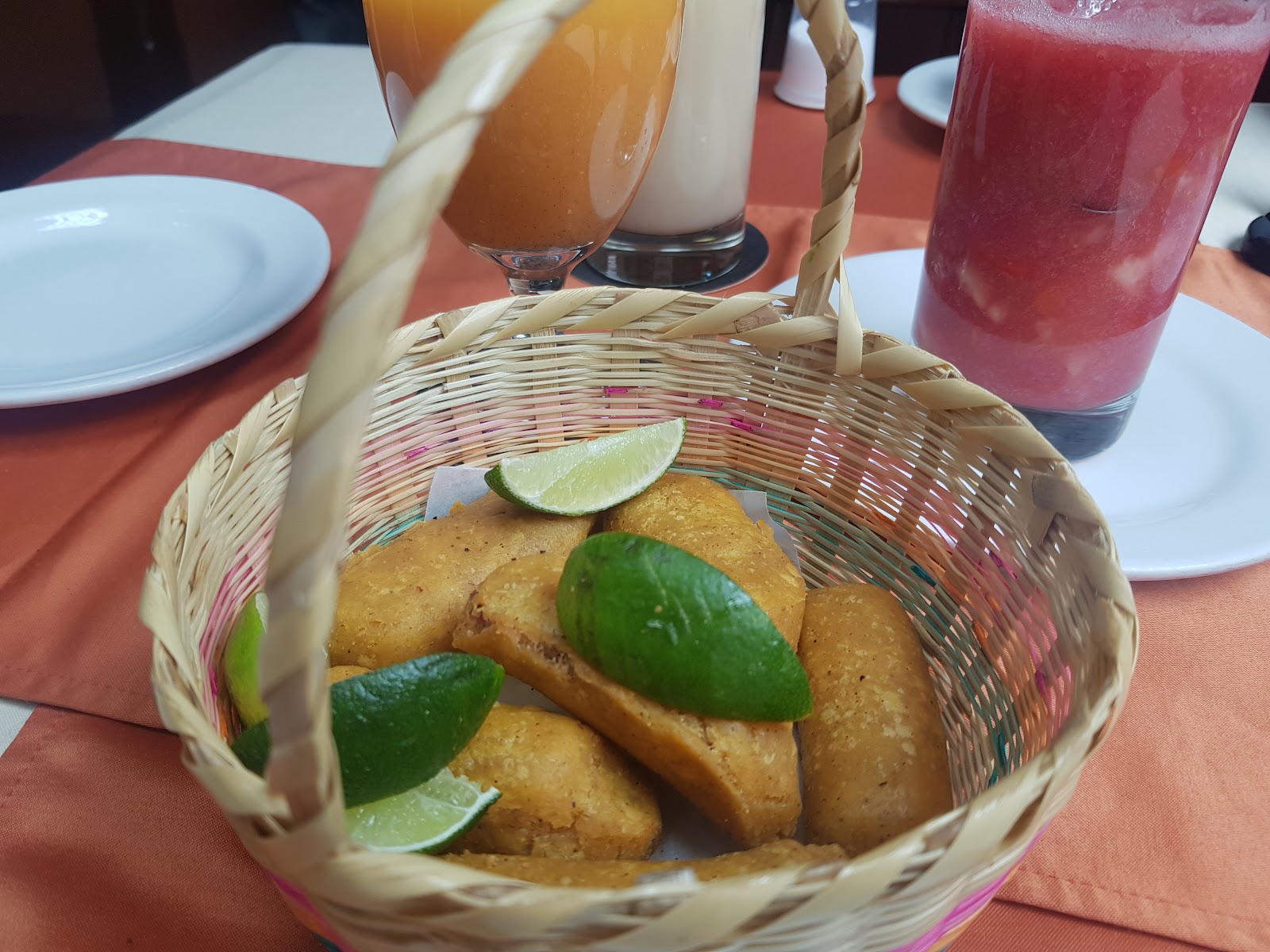
Just as famous and versatile as the Arepa is the Colombian Empanada. You might be wondering if this is really Colombian as there are many other Latin American countries (like Argentina) that are famous for their Empanadas. However, people have surely managed to create their own recipes and ingredients for this delicious filled pastry. Again, Empanadas will turn out to look very different depending on where you decide to try them (a good excuse to try several ones during your trip). The most common one is the Empanada made with pre-cooked yellow corn flour. Traditional fillings are ground meat, rice, potatoes or hogao, a sauce of tomatoes, onions and spices. You can try these, for example, at Las Margaritas in Bogotá. A restaurant with more than 100 years of tradition in preparing this delicious dish. Learn more about this place in our blog post.
Rumor has it that the name derived from an Italian baker in Valle del Cauca selling his pane buono (great bread). This snack is really a simple one, it’s basically just a soft bread with a cheesy flavor. However, you should take care because it can turn into a real addiction. The consistency and slightly floury taste are surprising and delicious. You can find them at many street stands along with Empanadas and Arepas. If you try one, make sure to ask for it “caliente” (warm).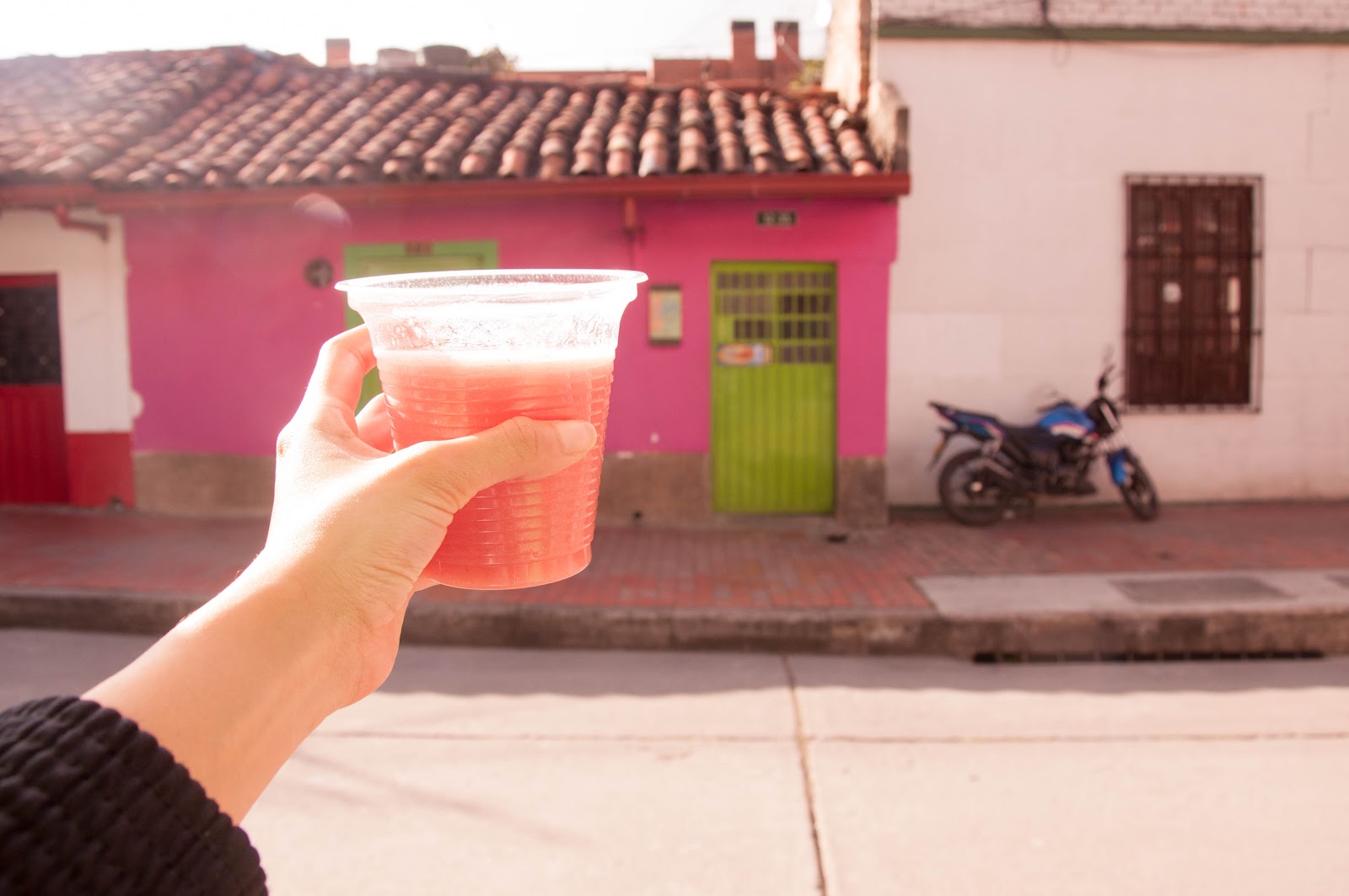
Juices are a very important element of the Colombian kitchen. But don’t think about your regular apple or orange juice. As there are many exotic fruits available in Colombia, the variety of juices is correspondingly large. It’s a good idea to visit a fruit market and try the juices there as you’ll be right at the source but there are also many stands on the streets where you’ll be able to taste the different types varying from slightly sour to sweet tastes. A few of the most common juices are mandarin, lulo, guanábana, uchuva (physalis), curuba and tomate del arbol (yes, that’s tomato juice but it’s sweet).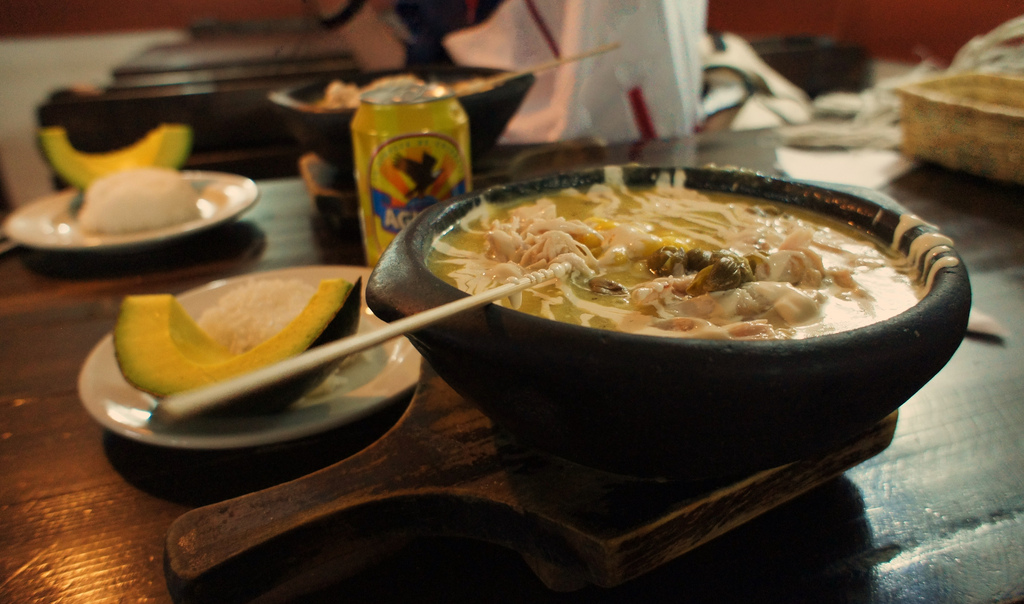
When asking a local what foods you should try, they will surely ramble on about this tasty soup called Ajiaco. One of the main ingredients for this dish are potatoes. Besides sabanera and pastusa potatoes, Ajiaco also contains Criolla potatoes. A small, yellow potato variation that enjoys a lot of popularity around Colombia. Other ingredients are chicken, onion, garlic and spices but believe us - potatoes are the key here as in many other Colombian dishes. When you get served an Ajiaco you will usually find a piece of cooked corn cob as addition and some avocado on the side. A filling and delicious option to go for!
You might notice the similarity in the name to Arepa paisa. This is because both of these dishes are from the same region - the northwest. A Bandeja Paisa is a quite complex dish. Not because of its components, which are rather simple, but because of the number of different elements you will find on your plate. The traditional version has beans, sweet fried plantain, rice, avocado, chicharron, chorizo, egg and ground meat. This carb-intensive combo results from the interesting history of the dish. The filling ingredients were often the only meal for workers in the region of Antioquia back when Bandeja Paisa was invented. If you are interested in hearing more stories about the background, check our blog post. A last piece of advice - be careful when ordering this because the portion size could be way too much for one person. Better to share!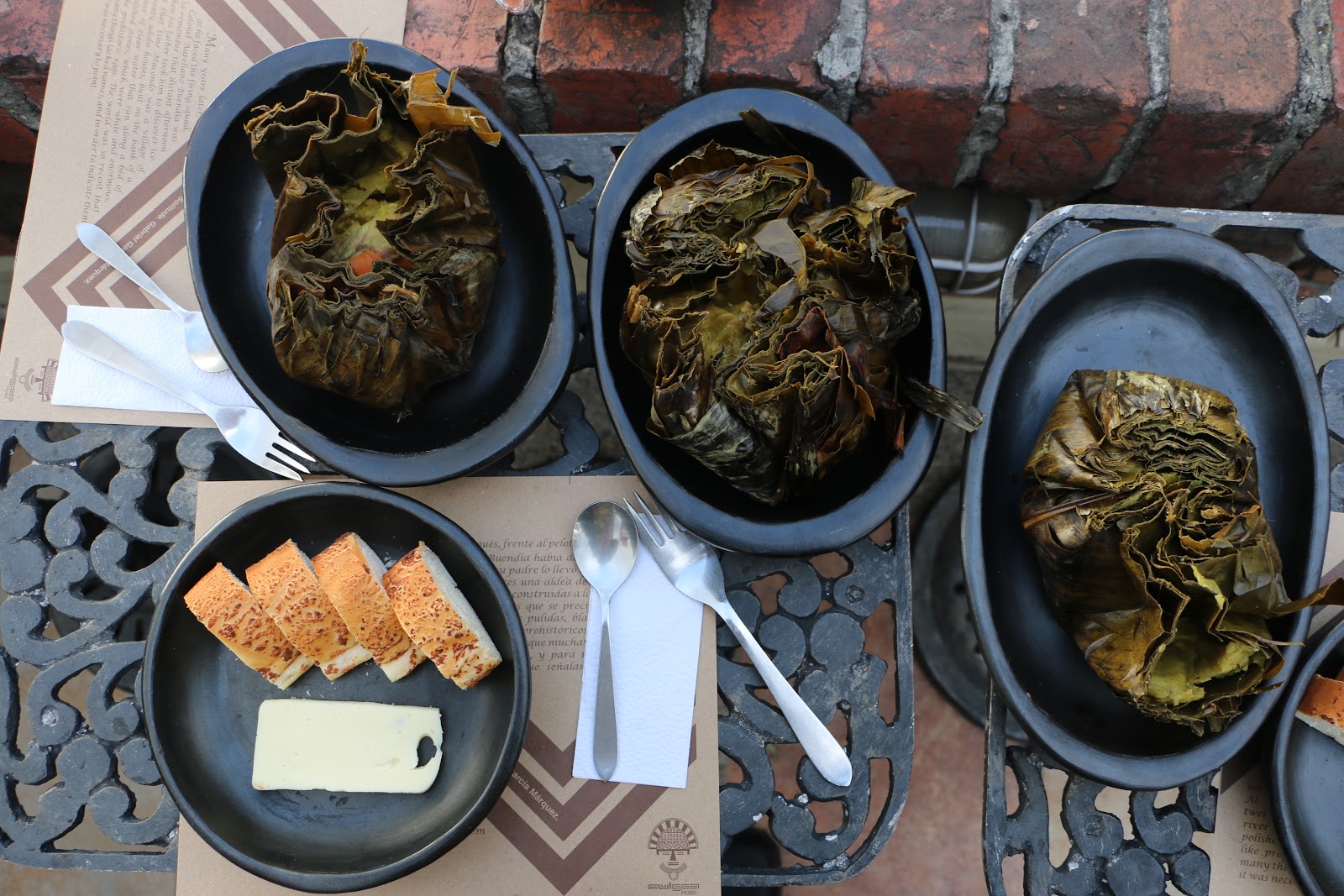
Tamales are another food that can be found all around the country. They can be served for breakfast, often accompanied by hot chocolate, or as a proper meal. This is another dish where the ingredients and preparation depend a lot on the origin but a classic Tamal contains corn as the base, peas, onion, pork and spices. The ingredients are mixed raw and wrapped in plantain leaves to be cooked for several hours. Other variations may contain rice, garbanzo beans and chicken.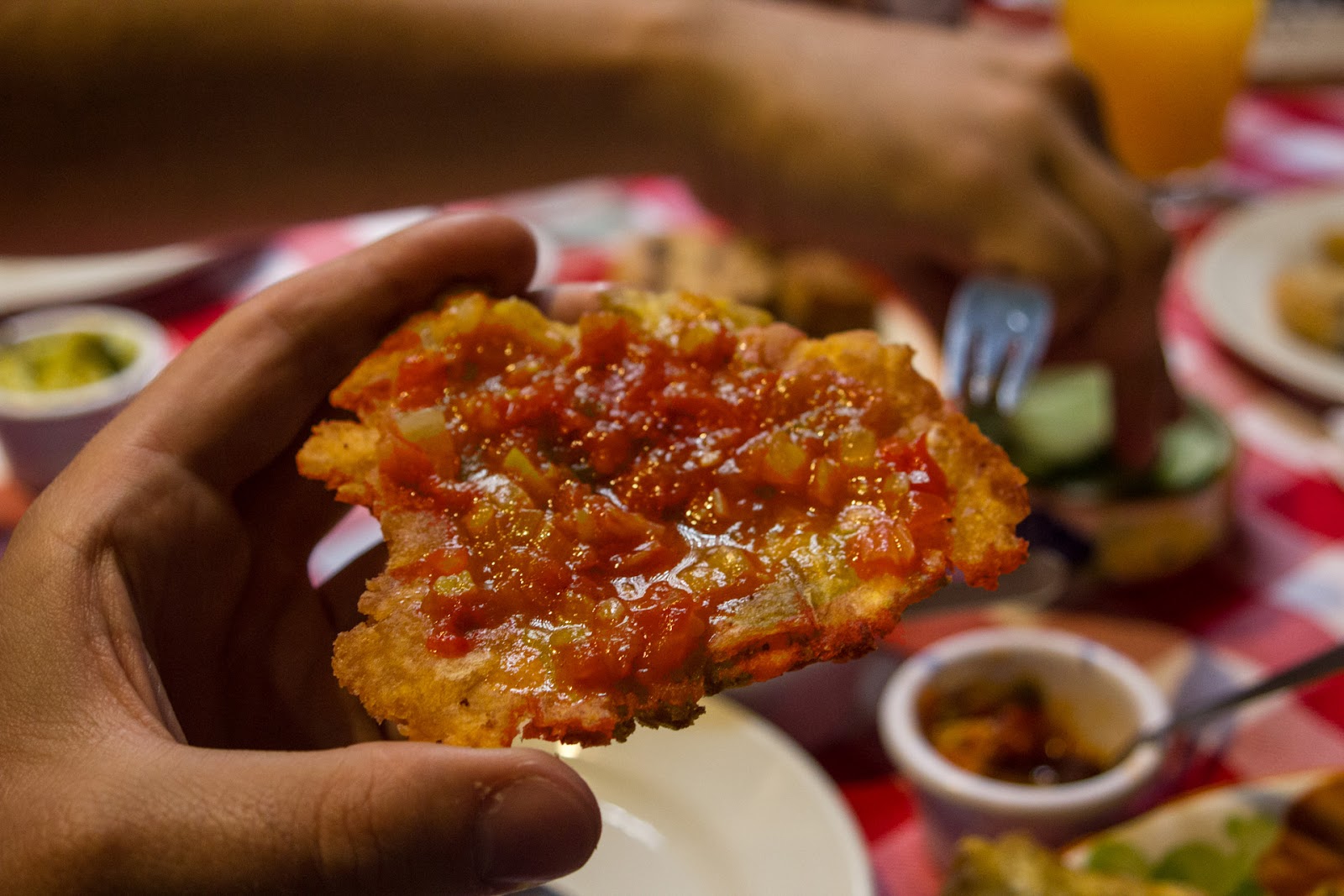
For Patacónes a green plantain is squashed, flattened and fried. These flattened plantains can then either be eaten as an appetizer with dip or they will be topped with things like meat, avocado and cheese to serve as a main dish. Plantain is a very common ingredient in the Colombian kitchen. The vegetable belongs to the family of bananas and looks similar to the popular fruit, only a lot larger. In contrast to its little sister, plantains always have to be cooked. Their taste varies from sweet to savory depending on the state of maturation.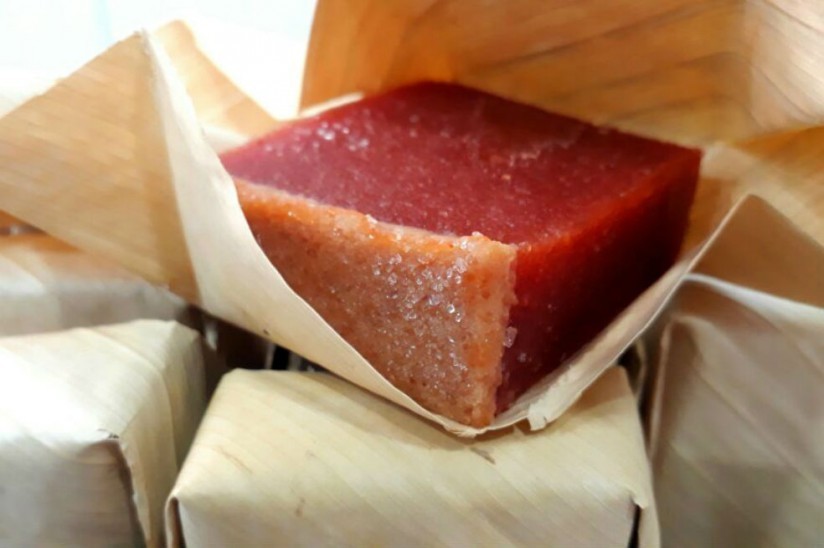
image source: http://diariodelcauca.com.co/noticias/nacional/bocadillo-que-no-se-haga-en-velez-no-puede-llamarse-bocadill-321304
If you visit a food market in Colombia, you will surely find a shop that sells Bocadillo. A sweet and soft block candy with a recognizable red to magenta color. But it’s not artificial! Bocadillo is made out of the Guava fruit which is why it is also called “Dulce the Guayabo” (Spanish for Guava sweets). It is often sold in portion-sized blocks wrapped in dried plantain leaves to serve as a little energy kick throughout the day. Apart from eating it pure, Bocadillo can also be found in some dishes like a filling for Pan de Bono or even in pizza crust. Colombians like to combine sweet and savory as you might recognize from this list.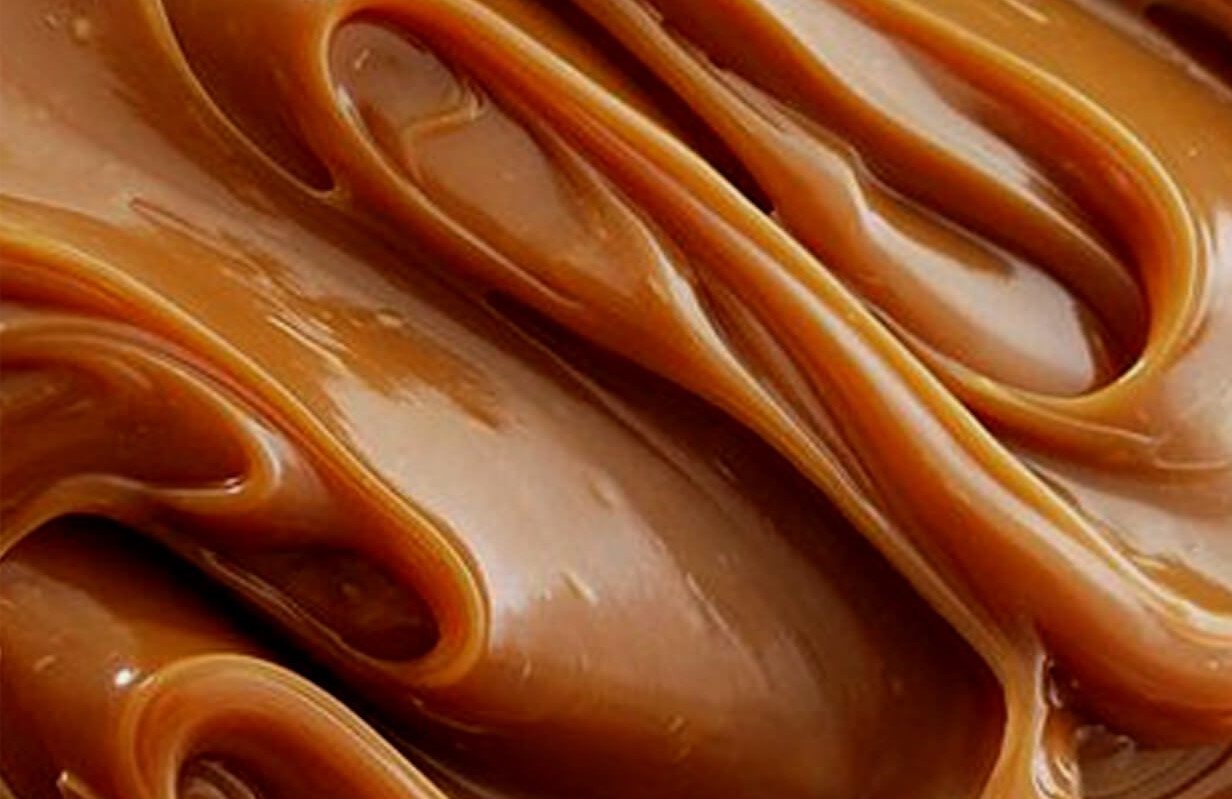
https://revistaialimentos.com/noticias/el-arequipe-aumenta-su-consumo-en-navidad-2/
This is one of the classic desserts. Arequipe is a sweet cream made out of milk and sugar with a slight caramel taste. It has a characteristic brownish color and can be consumed in several ways. There are little pots that you can eat pure as a snack. More often Arequipe will be found as an ingredient for other dishes such as a filling for Obleas and Pan de Bono, in cakes or pastries.
As you can see from this list, there are a lot of tempting traditional foods and drinks to be discovered here. If you can, always opt for the little restaurants at the side of the street to try these as this is usually where they are cooked the traditional way. What was your favorite dish you ever discovered on your travels? Let us know in the comments!
Sources:
https://www.eltiempo.com/archivo/documento/MAM-999020
This blog post will give you a quick look at the stars of the Colombian cuisine that you should give a try when traveling through this fascinating country.
Table of contents
1. Snacks
Arepa
The round, flat cornbread is a staple piece for breakfast or as a snack at any time of the day. As with most local foods, there are many regional recipes for this classic snack. One of the most popular ones is the Arpea paisa from the Antioquia region. This is really the simplest version as it only contains white corn flour and water. It is baked until crispy and then enjoyed with butter and salt. You can’t get out of trying an Arepa in this country. They are such a big topic here in Colombia that we have already written an entire blog post about this topic.
Empanadas
Just as famous and versatile as the Arepa is the Colombian Empanada. You might be wondering if this is really Colombian as there are many other Latin American countries (like Argentina) that are famous for their Empanadas. However, people have surely managed to create their own recipes and ingredients for this delicious filled pastry. Again, Empanadas will turn out to look very different depending on where you decide to try them (a good excuse to try several ones during your trip). The most common one is the Empanada made with pre-cooked yellow corn flour. Traditional fillings are ground meat, rice, potatoes or hogao, a sauce of tomatoes, onions and spices. You can try these, for example, at Las Margaritas in Bogotá. A restaurant with more than 100 years of tradition in preparing this delicious dish. Learn more about this place in our blog post.
Chicharrón
Chicharrón is not only one of the components of a classic Bandeja paisa but also a popular snack. It’s fried pork belly that you can eat in many dishes in restaurants or buy as a crispy snack in supermarkets. The pork belly is cooked in a little water and then fried in its own fat. Nothing for the faint-hearted vegetarian but any bacon-lover shouldn’t skip a trip to the restaurant to try some of these.Pan de Bono
Rumor has it that the name derived from an Italian baker in Valle del Cauca selling his pane buono (great bread). This snack is really a simple one, it’s basically just a soft bread with a cheesy flavor. However, you should take care because it can turn into a real addiction. The consistency and slightly floury taste are surprising and delicious. You can find them at many street stands along with Empanadas and Arepas. If you try one, make sure to ask for it “caliente” (warm).
Buñuelo
This is another friend of Pan de Bono and Arepa that you will find at the typical street food shops. Like Pan de Bono, a Buñuelo has a cheesy taste but the consistency and preparation method are very different. While Pan de Bono is baked, Buñuelos are fried which gives them a crispy outer “shell” and a soft interior. They are shaped roundly and often combined with Natilla (see below) in the Christmas season as a traditional dish. Fun fact: Buñuelo is also the Colombian word for an inexperienced driver.2. Drinks
Avena
This classic drink can be found packed in many supermarkets. However, the real, fresh Avena is better bought at the small snack shops in the streets. The vendors will often sell it out of a big tank. Avena is the Spanish word for oats, the drink’s main ingredient. It has a thick, smoothie-like consistency. The taste is sweet with a note of vanilla or cinnamon, again, depending on the region the recipe is from.Agua de Panela
Having a glimpse into the kitchen of any Colombian, there is one ingredient that you will always find - Panela. This is unrefined, whole cane sugar that can be used for many purposes. One of them is preparing Agua de panela or aguapanela. This recipe is not for gourmets as it is basically just sugar and water but it surely is an all-time favorite around the country. It can be consumed hot or cold, depending on the climate you’re in and usually contains some lime juice as well.Jugos (juices)
Juices are a very important element of the Colombian kitchen. But don’t think about your regular apple or orange juice. As there are many exotic fruits available in Colombia, the variety of juices is correspondingly large. It’s a good idea to visit a fruit market and try the juices there as you’ll be right at the source but there are also many stands on the streets where you’ll be able to taste the different types varying from slightly sour to sweet tastes. A few of the most common juices are mandarin, lulo, guanábana, uchuva (physalis), curuba and tomate del arbol (yes, that’s tomato juice but it’s sweet).
Aguardiente
Oh, the infamous Aguardiente. This liquor has a high potential to cause a hangover and yet is quite popular among Colombians. If you get the chance to party with locals, sooner or later you’ll be handed a shot glass with the clear drink. It has a strong taste of anise and though it may cause you a headache is something you should try if you get the chance.Hot Chocolate with Cheese
Hot Chocolate may not be a Colombian invention but their habit of combining it with cheese is surely unusual. The cheese has a rather mild taste and will be dipped into the hot chocolate (or thrown in altogether) so it melts slightly and gets a nice soft texture. The preparation method for hot chocolate is also a bit different around here. The cocoa is mixed with sugar and sold in hard-pressed blocks at the supermarket. These blocks are then either dissolved in milk or hot water using a specially formed whisk to mix it up.3. Meals
Ajiaco
When asking a local what foods you should try, they will surely ramble on about this tasty soup called Ajiaco. One of the main ingredients for this dish are potatoes. Besides sabanera and pastusa potatoes, Ajiaco also contains Criolla potatoes. A small, yellow potato variation that enjoys a lot of popularity around Colombia. Other ingredients are chicken, onion, garlic and spices but believe us - potatoes are the key here as in many other Colombian dishes. When you get served an Ajiaco you will usually find a piece of cooked corn cob as addition and some avocado on the side. A filling and delicious option to go for!
Bandeja Paisa
You might notice the similarity in the name to Arepa paisa. This is because both of these dishes are from the same region - the northwest. A Bandeja Paisa is a quite complex dish. Not because of its components, which are rather simple, but because of the number of different elements you will find on your plate. The traditional version has beans, sweet fried plantain, rice, avocado, chicharron, chorizo, egg and ground meat. This carb-intensive combo results from the interesting history of the dish. The filling ingredients were often the only meal for workers in the region of Antioquia back when Bandeja Paisa was invented. If you are interested in hearing more stories about the background, check our blog post. A last piece of advice - be careful when ordering this because the portion size could be way too much for one person. Better to share!
Tamales
Tamales are another food that can be found all around the country. They can be served for breakfast, often accompanied by hot chocolate, or as a proper meal. This is another dish where the ingredients and preparation depend a lot on the origin but a classic Tamal contains corn as the base, peas, onion, pork and spices. The ingredients are mixed raw and wrapped in plantain leaves to be cooked for several hours. Other variations may contain rice, garbanzo beans and chicken.
Patacón
For Patacónes a green plantain is squashed, flattened and fried. These flattened plantains can then either be eaten as an appetizer with dip or they will be topped with things like meat, avocado and cheese to serve as a main dish. Plantain is a very common ingredient in the Colombian kitchen. The vegetable belongs to the family of bananas and looks similar to the popular fruit, only a lot larger. In contrast to its little sister, plantains always have to be cooked. Their taste varies from sweet to savory depending on the state of maturation.
Chorizo
Chorizo is a sausage that is commonly included in various dishes around Colombia. It can traditionally be combined with Arepas, for example as a part of the filling for Arepa rellena, or added to soups and stews. It has also a lot of popularity in sandwiches and more recently has found its way into modern Hamburger variations.Changua
Opinions tend to differ about this traditional breakfast dish. Changua is a soup that has indigenous origins and is made out of milk with an egg inside. It is spiced with fresh cilantro and often potatoes are added to the soup. Changua is most common in the regions of Boyacá and Cundinamarca. A warm breakfast soup is a good way to start the day in these colder mountain climates!Sancocho
This is another traditional soup whose recipe varies a lot. Not only does every region have their own technique to prepare Sancocho, but it is also a dish that can be prepared with different main elements. There is chicken Sancocho, fish Sancocho or bean Sancocho. Next to these main ingredients, the soup contains local vegetables like corn. Rumor has it that Sancocho is one of the best cures for a hangover. So should you drink a little too much Aguardiente once on your trip it may be worth seeking a place to try this soup the next day.Lechona
This is a classic for any big celebration around the year, partly because it could suffice for more than one soccer team. Lechona is a whole pig with a filling of rice, spices and peas. The Lechona will be cut and you’ll receive a plate with a mixture of rice and pork along with a part of the crispy skin.4. Desserts
Bocadillo
image source: http://diariodelcauca.com.co/noticias/nacional/bocadillo-que-no-se-haga-en-velez-no-puede-llamarse-bocadill-321304
If you visit a food market in Colombia, you will surely find a shop that sells Bocadillo. A sweet and soft block candy with a recognizable red to magenta color. But it’s not artificial! Bocadillo is made out of the Guava fruit which is why it is also called “Dulce the Guayabo” (Spanish for Guava sweets). It is often sold in portion-sized blocks wrapped in dried plantain leaves to serve as a little energy kick throughout the day. Apart from eating it pure, Bocadillo can also be found in some dishes like a filling for Pan de Bono or even in pizza crust. Colombians like to combine sweet and savory as you might recognize from this list.
Arequipe
https://revistaialimentos.com/noticias/el-arequipe-aumenta-su-consumo-en-navidad-2/
This is one of the classic desserts. Arequipe is a sweet cream made out of milk and sugar with a slight caramel taste. It has a characteristic brownish color and can be consumed in several ways. There are little pots that you can eat pure as a snack. More often Arequipe will be found as an ingredient for other dishes such as a filling for Obleas and Pan de Bono, in cakes or pastries.
Natilla
Natilla is a dessert that is especially common around Christmas. It is a custard dessert made out of milk and sugar that has a slight vanilla taste. This dish is best served with some crispy fried Buñuelos.Obleas
This sweet treat is so versatile that it literally has something for everyone. Obleas are wafers made of flour, sugar, milk and water. They are round, very thin and crispy. The traditional way to try them is in a sort of sandwich. Two Obleas are filled with Arequipe and mild cheese and sometimes also blackberry marmalade. This is the most classic combination but as this dessert has become very popular there are now entire Oblea stores that sell them in uncountable varieties.As you can see from this list, there are a lot of tempting traditional foods and drinks to be discovered here. If you can, always opt for the little restaurants at the side of the street to try these as this is usually where they are cooked the traditional way. What was your favorite dish you ever discovered on your travels? Let us know in the comments!
Sources:
https://www.eltiempo.com/archivo/documento/MAM-999020







